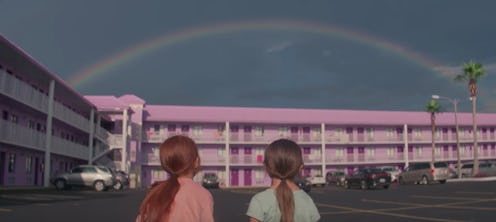
Director Sean Baker is known for his documentary-like movies. His last film, the indie hit Tangerine, was filmed entirely on an iPhone with a predominantly non-professional cast. So it's not surprising that viewers might assume that his newest film The Florida Project is a documentary. Unlike Tangerine, The Florida Project was filmed using actual cameras — on 35 mm film, to be precise — but the authentic quality of Baker's filmmaking still holds. The movie, out Oct. 6, follows one summer in the life of 6-year-old Moonee (Brooklynn Prince), a little girl living with her mother in a motel just a little ways away from Disney World in Orlando, Florida. And though it sounds an awful lot like your next true life obsession, The Florida Project isn't a documentary.
For most movie-goers, the fact that The Florida Project isn't a doc will become abundantly clear once star Willem Dafoe appears on the screen. Best known for playing the Green Goblin in Spider-Man (2002), Dafoe is an immediately recognizable actor and not the motel manager he plays in The Florida Project. The rest of the players, however, are relatively unknown. To assemble such an eclectic cast, Baker used conventional casting methods as well as street casting. "I always love to mix seasoned with first-timers and non-professionals," Baker told the Los Angeles Times. In a separate interview with Filmmaker Magazine Baker defined non-professional actors as people he'd pull off the street and ask to play in a scene. Not to be confused with first-timers like Florida Project co-star Bria Vinaite, who Baker found on Instagram.
Vinaite got the role of Moonee's mother Halley in The Florida Project almost completely by chance. Baker stumbled upon her Instagram page — @chronicflowers — and liked her style. After struggling to find a Hollywood actress who met his vision of Halley, he literally slid into Vinaite's DMs and asked if she'd audition for the part. "I kept going back to her page saying, 'You know, I wish we could find somebody in Hollywood like this.' And eventually somebody just said, 'Well why don't we just ask Bria?'" Baker recounted in an interview with Variety. She said yes, healthy skepticism and all, and the rest, as they say, is history. "For the longest time I thought it was like a joke, like someone was playing a sick joke on me," Vinaite told Variety.
But a fresh, new cast isn't the only thing that gives The Florida Project it's natural, documentary feel. Baker also allowed for a lot of improvisation on set, which helped get more natural performances, specifically from his young cast. "These 6-8 year olds took our scripted lines and riffed with it," he told Indiewire. "Sometimes they went off on something different, which was fine with me, as long as I was capturing the truth of the kids acting as naturally as possible."
Finally, the script, co-written by Baker and Chris Bergoch, also made a push for realism by focusing specifically on the very real issue of the "hidden homeless." For the filmmakers, the hidden homeless means those who, instead of going to a homeless shelter, set up makeshift homes in cheap motels. "I didn't know this even was an issue in the United States," Bergoch told Deadline, adding that he thought it would make the perfect backdrop for a movie about children. "I thought this would [be] an interesting opportunity to take that [idea], make an entertaining film, but deliver a message with it." By highlighting a real American struggle, The Florida Project acts as both a movie and a sort of empathetic exposé. "Sean is taking real life and turning in such a beautiful story that also gives it a lot of attention," Vinaite said in an interview with Mashable.
Even though The Florida Project is not a documentary, it hopes to bring light to the issue of poverty and homelessness by telling a realistic story as authentically as possible. That it's not true shouldn't shock you; that it might as well be should.